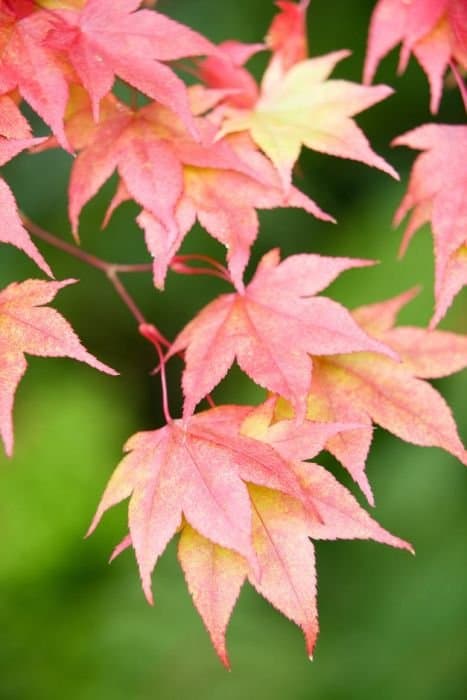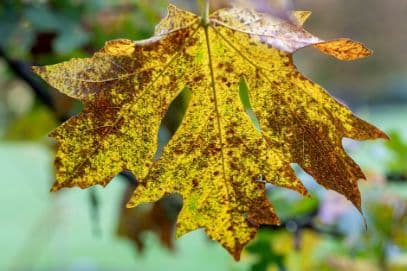Japanese Maple Acer palmatum 'Atropurpureum' (A)

ABOUT
The Japanese Maple 'Atropurpureum' is renowned for its aesthetic appeal, particularly during the fall. With a delicate and graceful form, its leaves are a standout feature. These leaves are shaped like the palm of a hand, with multiple pointed lobes that radiate from a central point, giving them a star-like silhouette. As hinted by the name 'Atropurpureum', the foliage of this variety of Japanese Maple boasts a deep burgundy or purplish-red color which can vary in intensity depending on light exposure and other environmental factors. This rich hue provides a striking contrast against the landscape, drawing the eye with its vibrant color. The leaves undergo a seasonal transformation, shifting to even more brilliant reddish colors in autumn, creating a spectacular display. The bark of the tree is typically a smooth gray, which can add to the visual interest, particularly in winter when the leaves have fallen, leaving the structural beauty of the branches on display. The overall appearance of the Japanese Maple 'Atropurpureum' is both elegant and striking, giving it a presence that can enhance any garden or cultivated space.
About this plant
 Names
NamesFamily
Sapindaceae.
Synonyms
Japanese Maple, Red Japanese Maple, Purple Japanese Maple, Bloodgood Japanese Maple, Red Leaf Japanese Maple.
Common names
Acer palmatum var. atropurpureum, Acer palmatum f. atropurpureum.
 Toxicity
ToxicityTo humans
The Japanese Maple is generally considered non-toxic to humans and ingestion typically does not result in any serious symptoms or consequences. However, as with any plant, individual sensitivities can vary, and it is always advisable to avoid ingesting plant material that is not confirmed as safe to eat.
To pets
The Japanese Maple is also considered non-toxic to pets. It is not known to cause any serious symptoms or severe consequences if pets ingest parts of the plant. As with humans, individual reactions can differ, so it is best to prevent pets from eating ornamental plants.
 Characteristics
CharacteristicsLife cycle
Perennials
Foliage type
Deciduous
Color of leaves
Purple
Height
15-25 feet (4.5-7.6 meters)
Spread
10-20 feet (3-6 meters)
Plant type
Tree
Hardiness zones
5-8
Native area
Japan
Benefits
 General Benefits
General Benefits- Aesthetic Appeal: Japanese maples are noted for their beautiful leaf shapes and colors, creating a striking focal point in any garden.
- Seasonal Interest: Offers year-round visual interest with its changing leaf colors in spring, summer, and fall, plus delicate branching patterns in winter.
- Versatility in Landscaping: Can be a standout specimen tree, part of a mixed border, or cultivated as a bonsai for smaller spaces.
- Shade Tolerance: Adapts well to a variety of light conditions, including shaded areas where other trees may struggle to grow.
- Low Maintenance: Generally requires minimal pruning and care once established, making it a good choice for both novice and experienced gardeners.
- Drought Resistance: Once established, it has a moderate level of drought resistance, reducing the need for frequent watering.
- Wildlife Habitat: Provides shelter and potential food sources for birds and other wildlife.
 Medical Properties
Medical PropertiesThis plant is not used for medical purposes.
 Air-purifying Qualities
Air-purifying QualitiesThis plant is not specifically known for air purifying qualities.
 Other Uses
Other Uses- Japanese maple (A) branches can be used in floral arrangements for their vibrant color and interesting shapes, adding an artistic touch to bouquets and centerpieces.
- The wood of the Japanese maple is sometimes used in the creation of musical instruments like flutes or woodblocks due to its fine grain and workability.
- The tree can serve as a natural sunshade in gardens, with its dense canopy providing a cool area during hot summer days.
- Fine woodworking, such as furniture making or decorative objects, might incorporate the wood of the Japanese maple for its attractive color and grain patterns.
- In miniature bonsai art, the Japanese maple is a popular subject because of its leaf shape, color, and adaptability to pruning.
- Leaves of the Japanese maple can be pressed and preserved in books or framed as a natural art form, capitalizing on their unique shape and color.
- Fallen leaves from the Japanese maple can provide mulch for garden beds, adding nutrients back into the soil as they decompose.
- This species of tree may serve as a natural privacy screen or windbreak in residential gardens.
- Photographers and painters often use the Japanese maple as a subject or backdrop due to its striking appearance across seasons.
- Culinary presentations can use Japanese maple leaves as ornamental garnishes due to their aesthetic appeal.
Interesting Facts
 Feng Shui
Feng ShuiThe Japanese Maple is not used in Feng Shui practice.
 Zodiac Sign Compitability
Zodiac Sign CompitabilityThe Japanese Maple is not used in astrology practice.
 Plant Symbolism
Plant Symbolism- Beauty: The Japanese Maple, especially the 'Atropurpureum' variety, is known for its stunning reddish-purple leaves, symbolizing beauty and grace in the plant world.
- Calmness: The serene shape and movement of its leaves in the wind are often associated with tranquility and peacefulness.
- Balance: The Japanese Maple's balanced and elegant growth habit signifies harmony and equilibrium.
- Endurance: Despite its delicate appearance, the Japanese Maple can be quite resilient, representing endurance and strength in adversity.
- Change: The changing colors of the leaves throughout the seasons reflect the theme of impermanence and the embrace of change and transformation.
 Water
WaterJapanese Maple should be watered regularly, especially during dry periods, with the aim of keeping the soil consistently moist but not waterlogged. During the first growing season, it's important to provide 1 to 1.5 gallons of water per week to help establish the root system. Once established, the frequency can be reduced, focusing on a deep water once a week, or more during extreme heat. Avoid overhead watering to prevent leaf scorch and diseases; instead, water at the base of the tree. Mulching around the base can help retain soil moisture.
 Light
LightJapanese Maples prefer a spot that receives partial shade, especially in the afternoon, to protect them from the harsh midday sun. Morning sunlight with afternoon shade is ideal to bring out the vivid colors of the leaves without causing leaf scorch. They thrive under the filtered light of taller deciduous trees or on the north or east side of buildings where they receive gentle morning light and avoid intense afternoon heat.
 Temperature
TemperatureJapanese Maples do best in a temperature range between 60°F and 80°F but can tolerate temperatures as low as 20°F and as high as 90°F for short periods. The ideal temperatures are moderate, as they can suffer from leaf scorch in hot, dry weather and can be damaged by severe frosts in winter. Protection from harsh conditions, especially in the case of young trees, can help ensure their survival and health.
 Pruning
PruningPruning Japanese Maples is primarily for shaping and removing any dead or damaged wood, and it is best done when the tree is dormant in late winter or early spring before new growth begins. Light pruning to shape the tree can be done in summer; however, major pruning should be avoided then to prevent excessive sap loss. Pruning every 2 to 3 years is often sufficient for maintaining a good shape and healthy tree.
 Cleaning
CleaningAs needed
 Soil
SoilThe Japanese Maple 'Atropurpureum' prefers moist, well-draining soil that is rich in organic matter, with a slightly acidic to neutral pH range of 5.5 to 7.5. The best soil mix for this plant often includes a blend of loam, peat moss, and sharp sand or perlite to enhance drainage and aeration.
 Repotting
RepottingJapanese Maples like 'Atropurpureum' should be repotted every 2-3 years when young, and less frequently as they mature, possibly only when rootbound which could take over 5 years.
 Humidity & Misting
Humidity & MistingThe 'Atropurpureum' variety of Japanese Maple prefers average to high humidity levels. It thrives best if humidity is maintained at a moderate level, typically between 40-60%.
 Suitable locations
Suitable locationsIndoor
Place in a bright spot, avoid dry heat, ensure pot has drainage.
Outdoor
Choose partial shade, shelter from harsh winds, mulch root zone.
Hardiness zone
5-9 USDA
 Life cycle
Life cycleThe Japanese Maple 'Atropurpureum' begins its life cycle as a seed which after a period of stratification, germinates in the spring. Once the seedling emerges and establishes its root system, it enters the juvenile phase, characterized by rapid vegetative growth and the development of its distinctive red-purple foliage. As the Japanese Maple matures, it transitions into the reproductive stage, where it produces small red or purple flowers in spring, which are followed by the formation of winged samaras (seed pods) that disperse with the wind in late summer or fall. The tree then reaches its adult phase, wherein it can live for several decades, experiencing annual cycles of growth, flowering, and dormancy. In the dormant season during the winter, the Japanese Maple loses its leaves, conserving energy and resources until conditions are favorable for new growth in the spring. With age, the tree's growth rate slows, and it may eventually reach senescence, where physiological functions decline leading to the end of its life cycle.
 Propogation
PropogationPropogation time
Early spring
The Japanese maple 'Atropurpureum' is best propagated by grafting, which is a horticultural technique where tissues from one plant are inserted into those of another so that the two sets may join together. This popular method usually occurs in late winter or early spring before the sap starts to flow. The understock or rootstock, which is typically a seedling of a more common Japanese maple, should be dormant when grafting. The scion wood, which is a cutting from the desired 'Atropurpureum', is collected while still dormant from healthy year-old growth and then grafted onto the rootstock using techniques such as whip grafting, tongue grafting, or side veneer grafting. Each method involves careful cutting of both scion and stock, so they fit together snugly and provide the maximum contact between the cambium layers of the graft partners to promote successful union and growth. After wrapping and sealing the graft union to prevent drying, the grafted plants are kept under appropriate conditions for the graft to heal and the scion to begin growth, a process which may take a few weeks.








